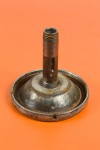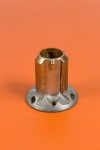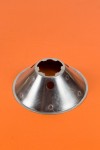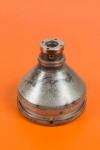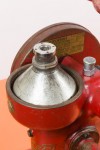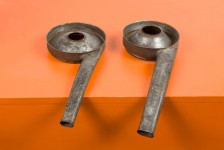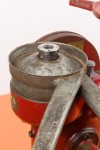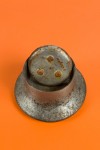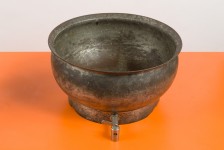Assembling a mechanical separator; the capacity to mechanically separate cream from milk transformed the dairy industry after its invention by Gustav de Laval in 1878. A process that had hitherto had to wait days for the action of gravity to allow the, less dense, cream part of the milk to rise could now be mechanised. This inaugurated the era of factory, or creamery made, butter.
This example is a hand powered Alfa Laval type separator made by Lister and Company. These, or similar, were commonplace in rural Ireland, though working models are now rare.
The images are free for not-for-profit or non-commercial use but we would appreciate if the Cork Butter Museum and the photographer, Roland Paschhoff were acknowledged.
- Component parts of an Alfa-Laval type hand powered mechanical separator. On the right, mounted on the base, is the housing for the motor; on the left is the bowl into which the whole milk is poured when operational. The other parts are explained as we proceed.
- Two views of the vertical pipe onto which the plates are mounted; note the slight indentation on the lower rim. Milk travels down this pipe and into the plates. (see MS 017)
- 2nd view (see previous)
- This piece is slotted onto the vertical shaft to give
- This piece is slotted onto the vertical shaft to give
- A plate or cone; this is at the centre of the centrifuge. The holes on the side of the plate allows for the flow of milk when operating
- An assemblage of the plates; note the small raised nipples on each plate. These keep a space between the plates when assembled
- The assembly of the plates; the nodule in 004 aligns the holes on the side of the cone
- The assembly of the plates; the nodule in 004 aligns the holes on the side of the cone
- The assembly of the plates; the nodule in 004 aligns the holes on the side of the cone
- The assembly of the plates; the nodule in 004 aligns the holes on the side of the cone
- The assembly of the plates; the nodule in 004 aligns the holes on the side of the cone
- The assembly of the plates; the nodule in 004 aligns the holes on the side of the cone
- The final plate; this has no holes on its sides
- A heavy cone shaped cover is set over the assemblage of plates which slots into the indenture noted in 002 and 003; note the threading on the top of the vertical shaft.
- The entire assemblage is bound together by a piece which is threaded onto the top of the shaft
- Representation of the movement of the milk on the assembled cone when operating. Hand powered separators could spin at 3,000 rpm.
- Engine housing
- View of the shaft, powered by the engine, onto which the cone is set
- View of the cone/centrifuge sitting in the engine housing
- Two outlet pipes, which sit, one on the other, over the cone; when operating, the less dense cream is extruded via the upper pipe and the, now skimmed, milk via the lower.
- Two outlet pipes, which sit, one on the other, over the cone; when operating, the less dense cream is extruded via the upper pipe and the, now skimmed, milk via the lower.
- Two outlet pipes, which sit, one on the other, over the cone; when operating, the less dense cream is extruded via the upper pipe and the, now skimmed, milk via the lower.
- Inverted and upright view of the next piece that sits on the outlet pipes; note the pipe for the milk to travel into the cone shaft
- Inverted and upright view of the next piece that sits on the outlet pipes; note the pipe for the milk to travel into the cone shaft
- Float set into the pipe assemblage the regulates the flow of milk from the bowl
- Inverted and upright view of the next piece that sits on the outlet pipes; note the pipe for the milk to travel into the cone shaft
- Inverted and upright view of the next piece that sits on the outlet pipes; note the pipe for the milk to travel into the cone shaft
- Inverted and upright view of the next piece that sits on the outlet pipes; note the pipe for the milk to travel into the cone shaft
- Float set into the pipe assemblage the regulates the flow of milk from the bowl
- Bowl into which the whole milk is poured.
- Separator assembled
- Separator in use; note to the two exit paths of the cream and the skimmed milk

